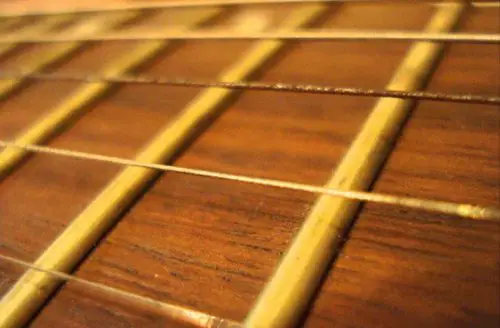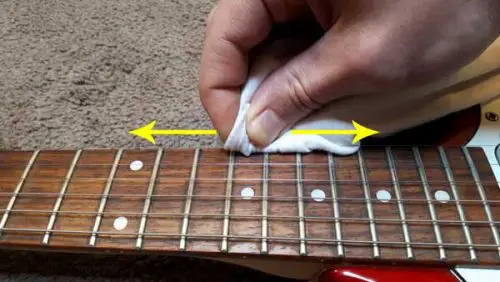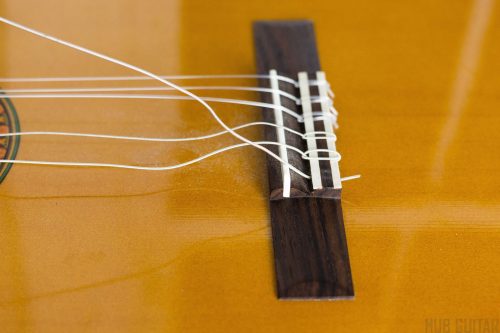A guitar string can snap on its own. One of the primary factors is simply the wear and tear that occurs over time. As guitar strings are constantly being plucked and strummed, they can become weakened and eventually break.
Here’s a list of common reasons why a guitar string could snap on its own:
- Wear and tear that occurs over time. As discussed above, this is the most common reason for guitar snapping on its own.
- High tension and vibrations placed on the strings during playing. It’s important to note that the quality and age of the strings can also play a role. Old or low-quality strings are more prone to breaking than newer, higher-quality ones.
- Changes in temperature and humidity. Extreme temperatures or sudden shifts in humidity levels can affect the tension and elasticity of the strings, leading to their breakage. This is why it’s important to store and maintain guitars in a stable environment.
- Improper installation or excessive bending of the strings. If the strings are not properly wrapped around the tuning pegs or if they are bent sharply at the bridge or nut, they can weaken and eventually snap.
- Manufacturing defects. While rare, it’s possible for a faulty string to have weak spots or imperfections that make it more prone to snapping.
Here’s a summary that sums up the entire article if you are too busy. Otherwise, read till the end because there are much more to the topic!
| Topic | Answer |
|---|---|
| Can a guitar string snap on its own? | Yes, a guitar string can snap on its own due to factors like wear and tear, changes in temperature and humidity, improper installation, and manufacturing defects. |
| How to know if your guitar strings will snap? | Signs that indicate if your guitar strings are at risk of snapping include visible wear and tear, loss of tone and clarity, difficulty staying in tune, sudden changes in pitch, and persistent buzzing or rattling sounds. |
| How to prevent guitar strings from snapping? | To prevent guitar strings from snapping, regularly change strings, choose high-quality strings, properly install and wind strings, avoid extreme temperatures and humidity, maintain proper string tension, use appropriate string gauges, and avoid excessive force when playing. |
| Can guitar strings break during playing? | Yes, guitar strings can break during playing due to factors such as tension and stress during vigorous playing, age and quality of the strings, and the presence of weak spots or imperfections. |
| Why do guitar strings break easily? | Guitar strings can break easily due to factors like worn-out strings, excessive tension, poor quality strings, improper installation, aggressive playing techniques, and environmental factors. |
| How to fix a broken guitar string? | To fix a broken guitar string, remove the broken string, replace it with a new one of the same gauge and type, thread the string through the tuning peg, wind the string, and tune and stretch the new string. |
How to know if your guitar strings will snap?

Rusty string will likely snap soon.
There are several signs that can indicate if your guitar strings are at risk of snapping:
1. Visible wear and tear: Inspect the strings closely for signs of fraying, rust, or corrosion. If you notice any weak spots or thin areas on the strings, it’s a good indication that they are nearing their breaking point.
2. Loss of tone and clarity: As guitar strings age and weaken, they lose their vibrant tone and clarity. If you notice a significant decrease in the quality of sound produced by your guitar, it may be a sign that the strings are reaching their breaking point.
3. Difficulty staying in tune: If you find yourself having to constantly retune your guitar, it could be a sign that the strings are becoming unstable. This can happen as the strings lose their tension and elasticity, making them more prone to snapping.
4. Sudden changes in pitch: Pay attention to any sudden changes in the pitch of the strings while you’re playing. If you hear a sharp increase or decrease in the pitch, it could be an indication that the string is about to snap.
5. Persistent buzzing or rattling sounds: When guitar strings are worn out and on the verge of snapping, they may produce buzzing or rattling sounds when played. This is typically caused by the weakened string vibrating against the frets.
To minimize the risk of your guitar strings snapping, it’s essential to take proper care of them. Here are some tips:
- Regularly clean and moisturize the strings to prevent rust and corrosion.
- Avoid excessive bending or sharp kinks when installing the strings.
- Use proper string gauges for your playing style and guitar type.
- Store your guitar in a controlled environment to prevent extreme temperature and humidity changes.
- Replace old or worn-out strings in a timely manner. As a general guideline, strings should be changed every 1-3 months, depending on the frequency of use.
By paying attention to these warning signs and taking proactive measures to maintain your guitar strings, you can reduce the likelihood of them snapping unexpectedly during your playing sessions.
How to prevent guitar strings from snapping?

Regularly clean your guitar strings from build up moisture, dirt and sweat.
While guitar strings can snap unexpectedly, there are measures you can take to minimize the risk:
1. Regularly clean your guitar strings: Regular maintenance and cleaning of your guitar strings can significantly extend their lifespan and prevent them from snapping prematurely. Sweat, dirt, and oils from your fingers can accumulate on the strings over time, leading to corrosion and weakening of the metal.
Use a clean cloth or specialized string cleaner to wipe down the strings after each playing session. This simple habit will help keep your strings in better condition, reducing the chances of unexpected breakage during performance or practice.
Also Read: Dirty Guitar Strings: 5 Reasons & Easy Ways To Clean Them
2. Regularly change your strings: Old and worn-out strings are more prone to breakage. It’s recommended to change your guitar strings every 1-3 months, depending on your playing frequency and the type of strings you use. Fresh strings are less likely to snap and will provide better tone and playability.
3. Choose high-quality strings: Invest in reputable brands and high-quality strings. These strings are often made with better materials and undergo rigorous quality control, making them more durable and less likely to snap prematurely.
4. Proper installation and winding: Ensure that your strings are properly installed and wound around the tuning pegs. Avoid excessive bending or sharp kinks when winding the strings. Incorrect installation can create weak spots along the string, increasing the risk of snapping.
5. Avoid extreme temperatures and humidity: Store your guitar in a stable environment with moderate temperature and humidity levels. Extreme changes in these factors can affect the tension and elasticity of the strings, making them more prone to breaking. Use a humidifier or dehumidifier when necessary to maintain optimal conditions.
6. Maintain proper string tension: Ensure that your guitar is properly set up and the string tension is properly adjusted. High string tension can put excessive stress on the strings, increasing the risk of breaking. Consult a professional or follow a proper setup guide to ensure your guitar is properly adjusted.
7. Use appropriate string gauges: Choose the right string gauge for your playing style and guitar type. Lighter gauge strings are generally less prone to breaking but may sacrifice some tone and volume. Heavier gauge strings can offer more durability but require stronger finger pressure. Experiment and find the right balance for your preferences.
Also Read: Beginner’s Guide: The Easiest String Gauge for Your Guitar
8. Avoid excessive force when playing: While it’s important to play with passion and energy, try to avoid excessive force or aggressive playing techniques. Strumming or picking too hard can put unnecessary strain on the strings and increase the risk of snapping. Develop a balanced and controlled playing technique.
By following these preventive measures, you can significantly reduce the chances of your guitar strings snapping unexpectedly. Remember to regularly inspect and maintain your guitar, and address any signs of wear or damage promptly to ensure optimal playing experience and longevity of your strings.
Can guitar strings break during playing?

Guitar strings can break during playing. While it may not be a common occurrence, several factors can contribute to a string breaking while you are playing. These factors include the tension and stress placed on the strings during vigorous playing, the age and quality of the strings, and even the presence of any weak spots or imperfections in the strings themselves.
When playing the guitar, the strings are continuously being stretched and released as they vibrate, and this puts strain on them. If you strum or pick the strings too aggressively or with excessive force, it can increase the likelihood of a string snapping. Additionally, if you often perform string bends or use techniques like intense vibrato, it can also contribute to string breakage, especially if the strings are already weakened or old.
The age and quality of the strings also play a role in their durability. Older or worn-out strings are more prone to breakage as they have undergone wear and tear from previous use. Lower-quality strings may also lack the strength and longevity of higher-quality strings, making them more susceptible to breaking.
Furthermore, if a string has any weak spots or imperfections, it becomes more vulnerable to snapping during playing. These weak spots can result from manufacturing defects or damage that occurred during installation or maintenance.
To minimize the risk of strings breaking during playing, it’s essential to maintain and replace your strings regularly, use appropriate string gauges for your playing style, and avoid excessively aggressive playing techniques. Additionally, proper string installation and handling, along with storing your guitar in a stable environment, can also help reduce the likelihood of string breakage.
How to fix a broken guitar string?
Fixing a broken guitar string involves a simple process:
1. Remove the broken string: Start by identifying the broken string on your guitar. Carefully loosen and unwind the broken string from the tuning peg and remove it from the bridge.
2. Replace the broken string: Prepare a replacement string that matches the gauge and type of the broken string. Insert one end of the new string into the bridge and secure it in place, making sure it is properly seated in the bridge saddle.
3. Thread the string through the tuning peg: Pull the other end of the string through the corresponding tuning peg. Leave a small amount of slack to work with. Ensure that the string is properly threaded through the peg’s hole.
4. Begin winding the string: While holding the string tension, start winding the string around the tuning peg in the direction that tightens the string. Make sure the coils are neat and evenly spaced.
5. Tune and stretch the new string: Once the replacement string is securely wound on the tuning peg, slowly tighten the string by turning the peg. Use a tuner to check the pitch and make adjustments until the string is in tune. Gently pull and stretch the string a few times to help it settle and maintain stable tuning.
It’s important to note that if one string has broken, it may be a good opportunity to replace all the strings on your guitar. This ensures consistent tone and tension across all strings and helps prevent further breakage.
When replacing strings, it’s recommended to change them all at once or follow a systematic pattern to maintain balance and stability in the guitar’s setup.
By following these steps, you can successfully fix a broken guitar string and resume playing. Remember to take your time and be gentle during the process to avoid any accidental damage to your guitar or injury to yourself.
Summary
In conclusion, while it may seem like guitar strings have a mind of their own when it comes to snapping, there are indeed various factors at play. Wear and tear, temperature and humidity changes, improper installation, and even manufacturing defects can contribute to the unfortunate breakup of a guitar string.
However, fear not, dear guitar enthusiasts! By staying vigilant and taking proactive measures, you can prevent premature string snapping. Regularly inspect and maintain your strings, choose high-quality replacements, and handle them with care.
Keep an eye out for warning signs of potential breakage, such as wear and tear, changes in tone, or difficulty staying in tune. And if you find yourself in a string emergency, fear not!
With a few simple steps, you can fix that broken string and get back to strumming those guitar chords like a rockstar. Remember, with the right knowledge and care, you can keep your guitar strings harmoniously intact and enjoy endless hours of music-making.





